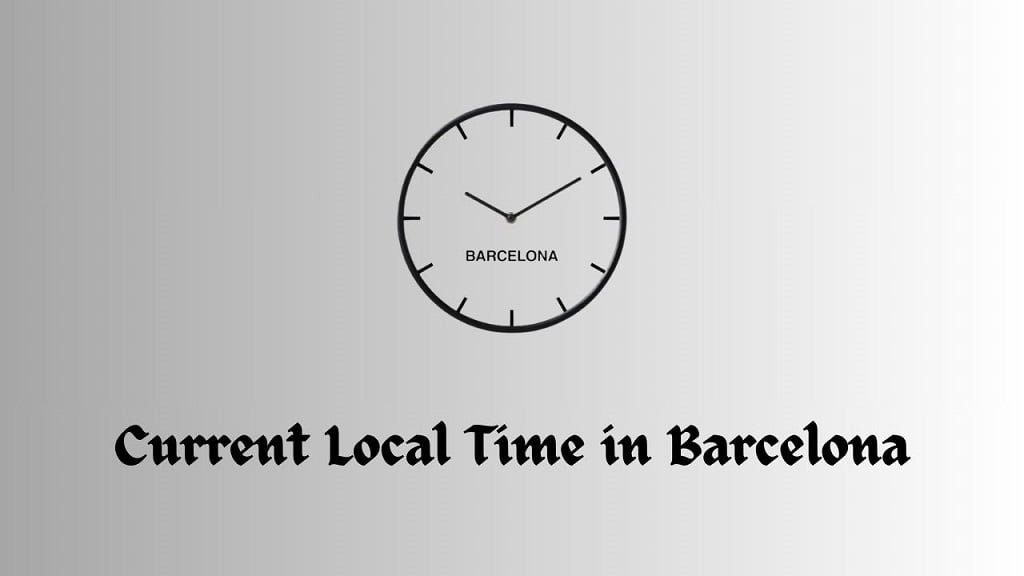Barcelona is a town located in Spain whose capital is Madrid. Barcelona follows Central European Time with a UTC offset of UTC +01:00. Barcelona does not follow daylight saving time.
Spain is divided into two time zones. Mainland Spain, including Barcelona, follows Central European Time (CET), which is GMT+01:00, aligning with cities like Paris, Berlin, and Rome. During Daylight Saving Time, Barcelona switches to Central European Summer Time (CEST), which is GMT+02:00. The Canary Islands, however, are on Western European Time (WET), which is GMT±00:00, and shift to Western European Summer Time (WEST), GMT+01:00, during summer.
Daylight saving time in Spain begins on the last Sunday of March at 01:00 GMT and ends on the last Sunday of October at 01:00 GMT. Historically, before World War II, mainland Spain followed Greenwich Mean Time (UTC±00:00), except for the Canary Islands, which were on GMT−01:00. The shift to CET occurred under Francisco Franco’s dictatorship during World War II to facilitate business transactions with Germany.
History of Barcelona Time Zone
Barcelona’s time zone history reflects a mix of geographic and political influences. Initially, Spain used local solar time. With the advent of standard time zones, Spain adopted Greenwich Mean Time (GMT). However, in 1940, under Francisco Franco’s regime, Spain switched to Central European Time (CET) to align with Nazi Germany, placing Barcelona an hour ahead of GMT.
The Canary Islands, part of Spain, remained on Western European Time, aligning with GMT. Today, Barcelona observes Daylight Saving Time, shifting to Central European Summer Time (CEST) during the summer. This time zone history showcases the impact of political decisions on everyday life.
Current Local Time in Barcelona, Spain

Barcelona, Spain currently observes Central European Time (CET), which is UTC+1. Currently, Barcelona does not observe daylight saving time. However, daylight saving time will begin on March 31st, at 01:00 AM UTC+0.
- Country: Spain
- Province: Barcelona (B)
- Barcelona Time Zone: Central European Time
- Time Zone Abbreviation: CET
- UTC Offset for Central European Time: +01:00 hours
- Is CET a Standard Time Zone?: Yes
- DST Ended Date: Oct. 29, 2023
- DST Starts Date: March 31, 2024
- Latitude: 41° 23′ North
- Longitude: 2° 1′ East
- Country Code: +34
Daylight Saving Time (DST) in Barcelona
Daylight Saving Time (DST) in Barcelona, Spain, typically follows the schedule observed across many European countries. Here’s an overview:
- Start of DST: DST in Barcelona usually begins on the last Sunday of March. At this time, clocks are advanced by one hour, moving from Central European Time (CET), which is UTC+1, to Central European Summer Time (CEST), which is UTC+2. This change effectively provides an extra hour of daylight in the evenings.
- End of DST: DST ends on the last Sunday of October. At this point, the clocks are turned back by one hour, reverting from CEST (UTC+2) to CET (UTC+1). This shift aligns with the shorter days and longer nights of the winter season.
- Purpose: The primary rationale behind DST is to make better use of daylight during the longer days of summer. By shifting the clocks forward, it’s believed that energy consumption can be reduced since there’s less need for artificial lighting in the evenings.
- Controversy and Changes: DST has been a subject of debate, with arguments regarding its actual benefits in terms of energy savings and the impact on people’s health and circadian rhythms. The European Union has considered proposals to abolish DST, allowing member states to choose their standard time permanently. However, as of my last update, no final decision had been implemented.
During DST, Barcelona’s time aligns more closely with Eastern European countries rather than with its geographical neighbors along the same longitude. This can affect international scheduling and activities like travel and business meetings.
Does Barcelona have 2 time zones?
No, Barcelona does not have two time zones. The entire city of Barcelona, like most of mainland Spain, operates on a single time zone. This time zone is Central European Time (CET), which is UTC+1. During daylight saving time, Barcelona, along with the rest of mainland Spain, switches to Central European Summer Time (CEST), which is UTC+2.
It’s worth noting that Spain as a country does have two time zones, but this is because of its geographical diversity. Mainland Spain, including cities like Barcelona, Madrid, and Valencia, uses CET/CEST.
However, the Canary Islands, which are also part of Spain, use Western European Time (WET, UTC+0) and Western European Summer Time (WEST, UTC+1). This difference is due to the geographical location of the Canary Islands, which are located off the northwest coast of Africa.
Is Barcelona GMT or CET?
Barcelona is in the CET time zone, which stands for Central European Time. CET is UTC+1, meaning it is one hour ahead of Greenwich Mean Time (GMT). During daylight saving time, typically from the last Sunday in March to the last Sunday in October, Barcelona switches to Central European Summer Time (CEST), which is UTC+2.
Barcelona is at The Same Time as Nigeria
Barcelona, Spain, and Nigeria are not in the same time zone. Barcelona operates on Central European Time (CET), which is UTC+1 and switches to Central European Summer Time (CEST), UTC+2, during daylight saving time. On the other hand, Nigeria is on West Africa Time (WAT), which is also UTC+1, but Nigeria does not observe daylight saving time.
This means that when daylight saving time is not in effect, Barcelona and Nigeria share the same time. However, during the period when daylight saving time is observed in Barcelona (typically from the last Sunday in March to the last Sunday in October), Barcelona is one hour ahead of Nigeria.
Conclusion
The time zone of Barcelona, which aligns with Central European Time (CET) for most of the year and shifts to Central European Summer Time (CEST) during daylight saving months, illustrates a blend of historical, geographic, and practical considerations in timekeeping.
Despite being geographically more aligned with the Greenwich Mean Time (GMT) zone, Barcelona follows CET (UTC+1) along with many central European countries, a practice established for standardization and efficiency in international dealings. This alignment is further adjusted during daylight saving time to CEST (UTC+2), reflecting an effort to optimize daylight usage, though this practice remains a topic of debate.
Barcelona’s time zone history, influenced by political decisions like those during Franco’s regime and practical considerations for energy saving, exemplifies how timekeeping can be shaped by a variety of factors, impacting daily life and global interactions.










![What Does Aviates Stand for in Aviation? [The Art of Flying] Aviates](https://tourinplanet.com/wp-content/uploads/2024/07/Aviates-100x75.jpg)














![25 Best Peruvian Foods You Must Try In Peru [With Recipes] Peruvian Food](https://tourinplanet.com/wp-content/uploads/2024/07/Peruvian-Food-100x75.jpg)


